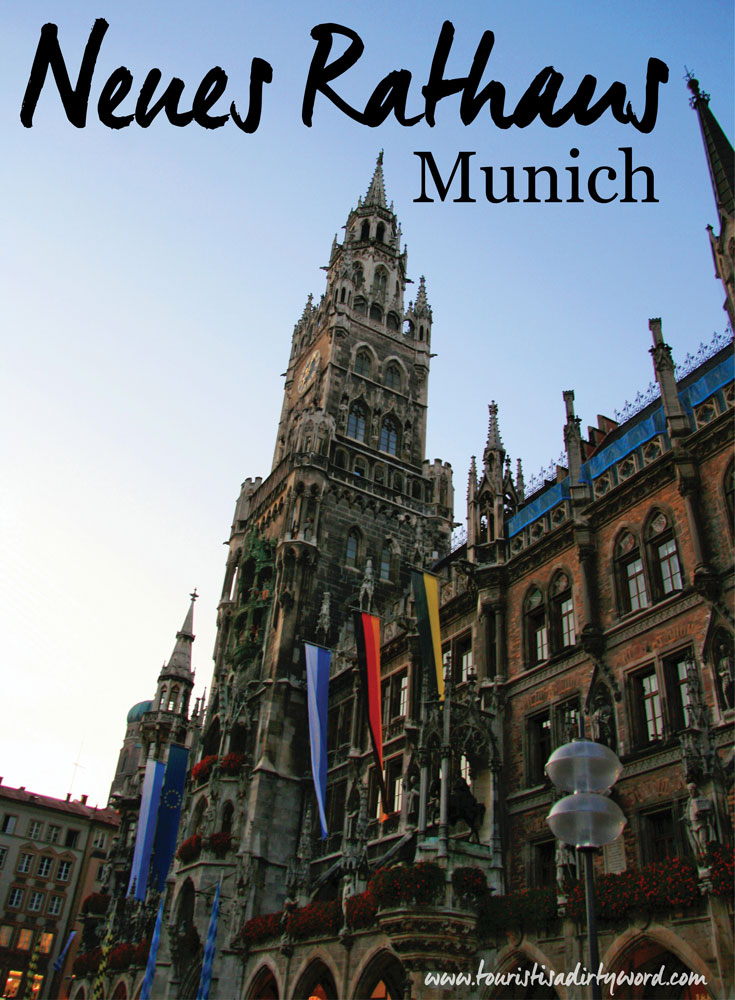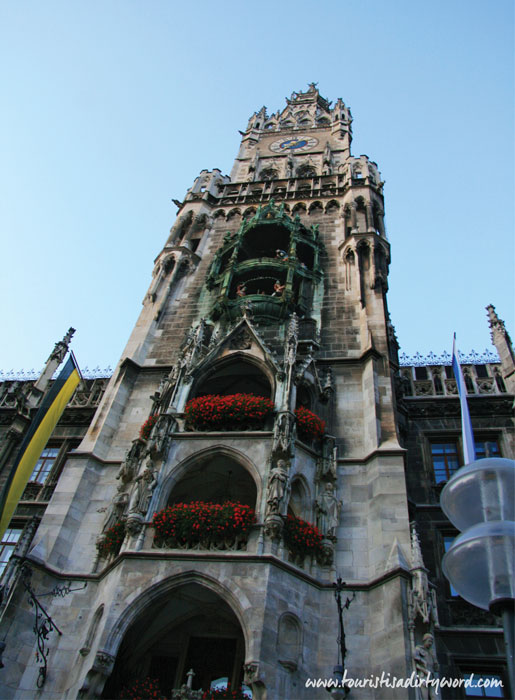Disclosure: Please note that some links are affiliate links, and at no additional cost to you, we earn a commission if you make a purchase.
If you would like to support this website in some way, using these links will help do exactly that.

After a full day exploring Oktoberfest, we walked into the old part of Munich. Sensory overloaded from the beautiful costumes and wonderful food of the day, I waddled with my belly full of pretzels, chicken, and beer up this very pointy, church-looking building. The red flowers were shocking amongst the shadowy arcade of windows behind them. When I noticed all of the different flags on the side of the building, I realized it wasn’t a church.
It was the new town hall, Neues Rathaus, where the mayor and city council hold office, and the general headquarters of the Munich city administration. Briefly the memory of our own, gymnasium, institutional-looking city council building back home in Florida shimmers in my mind before dissolving into the beauty before me. It could have been all of the pretzels, but I was confused. Why was this the new town hall, and why did it look so old? And why did it look like a church?
Well, it's complicated, but I’m going to make it super simple..
First, a SUPER basic overview of European architecture (in chronological order) Romanesque to Gothic, to Renaissance, to Gothic Revival.
Romanesque, think sturdy and basic.
Easy way to remember it is the buildings look like sturdy, basic, buildings that could be recreated with preschool wooden building blocks. They got the job done, and didn’t get fancy. [6th century, thereabouts, to late 10th century]
Gothic architects looked at Romanesque buildings and thought, ‘meh, I can do better. Buildings don’t have to be boring.’
Gothic, think skeletal and busy.
Easy way to remember it is the builders wanted to go as high as possible, and let as much light in as possible.
Its easy to go taller if its pointy right? So Gothic has mostly pointy edges.
Want more light? Add more windows. LOTS of windows.
To make the building withstand all the weight now that it's so tall and has tons of windows, it needs more support, but no one wants to LOOK at enormous supporting columns. So they put them outside the building. That’s where the flying buttresses come swooping in to the rescue. Then they didn’t have facebook or instagram to distract them, so they decorated every inch of it. The buildings look visually busy. [12th century in France to 16th century]
Renaissance architects looked at Gothic buildings and thought, ‘Oh my goodness! My eyes are bleeding it’s so busy! Why recreate the wheel, the Greeks and Romans already figured out this stuff, we should just recreate that.’
Renaissance, think columns and geometric.
Easy way to remember it is renaissance sounds like reminisce, as in reminiscing about those old roman/greek glory days.
So here comes the primary school wooden building blocks again. I’ll give them this though, it is a bit more elegant, with a focus on symmetry, decorative columns, and oh-so-pleasing geometric shapes. They cheated a little and used gothic architecture engineering then covered up their tracks with thick, plain walls again. -15th century to 17th century-
Gothic Revival architects looked at Renaissance buildings, then Gothic buildings, then Renaissance buildings again...and thought 'We’re GERMAN. Not Romans, or Greeks! We’re German! We should have German buildings!' I have to mention that Gothic Architecture didn’t actually originate in Germany, it originated in France. Gothic wasn’t POPULAR in France any more! So the Germans thought this was solely their style.
Gothic or Gothic Revival?
The biggest difference between Gothic and Gothic Revival is time, 12th-15th century Gothic, 18th-20th century Gothic Revival. Beyond that, if the stone work looks more uneven, and there are obvious, huge, flying butresses, its likely Gothic. With new building techniques in the 18th-20th century the stones were much smoother and buttresses were not always necessary to support the building's weight.
You just learned how to identify four forms of architecture with a few minutes of reading! Hi-Five! For all my visual learners out there, I took some of my photos of the Munich Neues Rathaus and labeled it with visual clues that its gothic.

Back to the Neues Rathaus in Munich-
Why did the Neues Rathaus in Munich look so old?
Well, although it was built by Georg von Hauberrisser between 1867-1874, which isn’t all that long ago, the popular sentiment at the time believed life was better during medieval times, which had the gothic architecture. This building is part of the Gothic Revival period. They wanted to revive the self-governing glory days of the medieval times and Hanseatic League. It was a close call though. The Munich new town hall was almost Renaissance style. Click here for more about that, and I promise its brief too.
Why did the Neues Rathaus in Munich look like a church?
You know how when there’s a sequel to a movie, usually it's not as memorable as the first one? The first image that pops in my mind when you say Gothic is actually the Notre Dame cathedral in Paris, as well as many other churches. During the 12th and 16th century, when Gothic was born, they only had the time, energy, and motivation to go all out designing churches, and that’s what’s memorable. However, with gothic revival, just like the Neues Rathaus, they started applying that style of design to any type of building, civic buildings included.
Munich simply outgrew their Old Town Hall, which is still standing just around the corner. They even added additional annexes between 1899-1903. For the finishing touch, in 1908 they added a charming glockenspiel to the front facade.
Here are two glockenspiel videos from the Neues Rathaus in Munich, one is for day time, and the other is for night.
Other features worthy of note, there’s over 400 hundred rooms, you can go up to the 255-ft tall observation deck for a fantastic aerial view, and there’s a restaurant dating from 1867 in the basement.

Follow Along
If you enjoyed this article, or these topics sound interesting to you, you'll love our weekly newsletter. You'll receive the newest posts each week and exclusive access to free planning resources like ‘Packing List & Tips for 2 Weeks in Germany’ and ‘Everything You Need to Rent a Car in Germany’.
Thank you for reading!

Bonus Resource: This book, The Gothic Revival by Michael J. Lewis was incredibly helpful in my research on this post about the Neues Rathaus. It's still available for sale on amazon (affiliate link). Chapter 3 was especially insightful on understanding Germany's perspective on the Gothic Revival.
Lewis, Michael J. The Gothic Revival. New York: Thames & Hudson, 2002. Print. Thames & Hudson World of Art.
